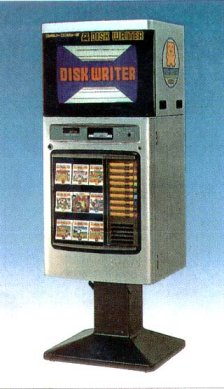Disks and games were available several ways in Disk System land. First, you could buy a blank three-inch disk for 2000 yen, and have the game of your desire read in for an extra 500 yen. After that, you could use the same disk again and again, reading in different games once you got bored of one. Each game-swap cost only 500 yen, compared for the 5000 yen prices for cartridge-based games of the time. Even after cart technology surpassed the disks, the System remained popular merely for this price factor. Another way was to buy a disk with the game you want already read in, complete with manual, for anywhere from 2600 to 3500 yen. This is what's referred to as "brand new" disks - the disks themselves are in clear hard-plastic cases, and are sold with manual in another, softer plastic case with a sticker sealing the case shut. If the seal is undamaged then you can consider the disk to be never used. 95 percent of games fall into one of these categories. Certain games - mostly 1988-89 era Disk System ports of old Nintendo or Konami-made cartridge games - were available on disk solely via the Disk Writer and could not be bought on disk separately. Certain other games, like Bubble Bobble, Topple Zip, and Hikaru GENJI: Roller Panic were sold only by themselves - you couldn't read them in via the Disk Writer. Most of these independent games had cooler packaging than regular cartridge games, and some came with little toys or figures (Roller Panic comes in a CD case with a ton of freebies inside). Nintendo was apparantly a little more lax in their Disk System packaging guidelines than on regular Famicom cart packaging. Porno games were also (of course) not sold via the Nintendo-owned Disk Writers. Most titles were sold in record album-style flat cases, but one or two were sold in the traditional Hacker International-style VHS cassette sized plastic case. Hacker reverse-engineered the disk format circa 1988, long before they started releasing Famicom cartridge games of their own. Back...
|
